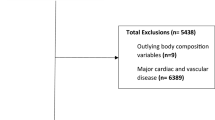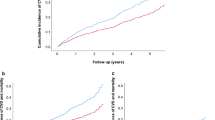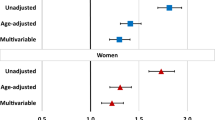Abstract
Epicardial fat thickness (EFT) has emerged as a marker of cardiometabolic risk, but its clinical use warrants proper knowledge of its distribution and associations in populations. We aimed to describe the distribution of EFT, its demographic correlates and independent associations with diabetes, hypertension and metabolic syndrome (MS) in free-living Brazilian adults. From the baseline echocardiography of the Brazilian Longitudinal Study of Adult Health (ELSA-Brasil)—a cohort study of civil servants aged 35–74 years—EFT was measured from a randomly selected sample of 998 participants as the mean of two paraesternal windows obtained at end systole (EFTsyst) and end diastole (EFTdiast). From the 421 individuals free of diabetes, hypertension and MS, we defined EFT reference values and the EFTsyst 75th percentile cut-off. Median EFTsyst was 1.5 (IQR 0–2.6) mm; a large proportion (84 %) had EFTdiast = 0. EFT was higher in women and lower in blacks, and increased with age and BMI. Although EFT was higher in those with diabetes, hypertension, and MS, EFT associations were reduced when adjusted for age, sex and ethnicity, and were non-significant after adjusting for obesity measures. In conclusion, the amount of EFT in this large multiethnic population is smaller than reported in other populations. EFT reference values varied across demographic and clinical variables, EFT associations with cardiometabolic variables being largely explained by age, sex, ethnicity and central obesity. Although EFT can help identify individuals at increased cardiometabolic risk, it will likely have a limited additional role compared to current risk stratification strategies.


Similar content being viewed by others
References
Sacks HS, Fain JN (2007) Human epicardial adipose tissue: a review. Am Heart J 153:907–917
Iacobellis G, Willens HJ (2009) Echocardiographic epicardial fat: a review of research and clinical applications. J Am Soc Echocardiogr 22:1311–1319. doi:10.1016/j.echo.2009.10.013
Pierdomenico SD, Pierdomenico AM, Cuccurullo F, Iacobellis G (2013) Meta-analysis of the relation of echocardiographic epicardial adipose tissue thickness and the metabolic syndrome. Am J Cardiol 111:73–78. doi:10.1016/j.amjcard.2012.08.044
Iacobellis G, Assael F, Ribaudo MC et al (2003) Epicardial fat from echocardiography: a new method for visceral adipose tissue prediction. Obes Res 11:304–310. doi:10.1038/oby.2003.45
Nelson MR, Mookadam F, Thota V et al (2011) Epicardial fat: an additional measurement for subclinical atherosclerosis and cardiovascular risk stratification? J Am Soc Echocardiogr 24:339–345
Verhagen SN, Visseren FLJ (2011) Perivascular adipose tissue as a cause of atherosclerosis. Atherosclerosis 214:3–10. doi:10.1016/j.atherosclerosis.2010.05.034
Guzzardi MA, Iozzo P (2011) Fatty heart, cardiac damage, and inflammation. Rev Diabet Stud RDS 8:403–417. doi:10.1900/RDS.2011.8.403
Yudkin JS, Eringa E, Stehouwer CDA (2005) “Vasocrine” signalling from perivascular fat: a mechanism linking insulin resistance to vascular disease. Lancet 365:1817–1820. doi:10.1016/S0140-6736(05)66585-3
Meijer RI, Serne EH, Smulders YM et al (2011) Perivascular adipose tissue and its role in type 2 diabetes and cardiovascular disease. Curr Diab Rep 11:211–217. doi:10.1007/s11892-011-0186-y
Aquino EML, Barreto SM, Bensenor IM et al (2012) Brazilian Longitudinal Study of Adult Health (ELSA-Brasil): objectives and design. Am J Epidemiol 175:315–324. doi:10.1093/aje/kwr294
Schmidt MI, Duncan BB, Mill JG et al (2015) Cohort Profile: Longitudinal Study of Adult Health (ELSA-Brasil). Int J Epidemiol 44:68–75. doi:10.1093/ije/dyu027
Lang RM, Bierig M, Devereux RB et al (2006) Recommendations for chamber quantification. Eur J Echocardiogr 7:79–108. doi:10.1016/j.euje.2005.12.014
Gottdiener JS, Bednarz J, Devereux R et al (2004) American Society of Echocardiography recommendations for use of echocardiography in clinical trials. J Am Soc Echocardiogr 17:1086–1119
Mancia G, De Backer G, Dominiczak A et al (2007) 2007 Guidelines for the management of arterial hypertension: the task force for the management of arterial hypertension of the European Society of Hypertension (ESH) and of the European Society of Cardiology (ESC). Eur Heart J 28:1462–1536. doi:10.1093/eurheartj/ehm236
Alberti KGMM, Eckel RH, Grundy SM et al (2009) Harmonizing the metabolic syndrome: a joint interim statement of the International Diabetes Federation Task Force on Epidemiology and Prevention; National Heart, Lung, and Blood Institute; American Heart Association; World Heart Federation; International Atherosclerosis Society; and International Association for the Study of Obesity. Circulation 120:1640–1645. doi:10.1161/CIRCULATIONAHA.109.192644
Lai Y-H, Yun C-H, Yang F-S et al (2012) Epicardial adipose tissue relating to anthropometrics, metabolic derangements and fatty liver disease independently contributes to serum high-sensitivity C-reactive protein beyond body fat composition: a study validated with computed tomography. J Am Soc Echocardiogr 25:234–241. doi:10.1016/j.echo.2011.09.018
Pierdomenico SD, Pierdomenico AM, Neri M, Cuccurullo F (2011) Epicardial adipose tissue and metabolic syndrome in hypertensive patients with normal body weight and waist circumference. Am J Hypertens 24:1245–1249. doi:10.1038/ajh.2011.134
Momesso DP, Bussade I, Epifanio MA et al (2011) Increased epicardial adipose tissue in type 1 diabetes is associated with central obesity and metabolic syndrome. Diabetes Res Clin Pract 91:47–53. doi:10.1016/j.diabres.2010.09.037
Iacobellis G, Ribaudo MC, Assael F et al (2003) Echocardiographic epicardial adipose tissue is related to anthropometric and clinical parameters of metabolic syndrome: a new indicator of cardiovascular risk. J Clin Endocrinol Metab 88:5163–5168
Ahn S-G, Lim H-S, Joe D-Y et al (2008) Relationship of epicardial adipose tissue by echocardiography to coronary artery disease. Heart 94:e7. doi:10.1136/hrt.2007.118471
Rabkin SW (2014) The relationship between epicardial fat and indices of obesity and the metabolic syndrome: a systematic review and meta-analysis. Metab Syndr Relat Disord 12:31–42. doi:10.1089/met.2013.0107
Bertaso AG, Bertol D, Duncan BB, Foppa M (2013) Epicardial fat: definition, measurements and systematic review of main outcomes. Arq Bras Cardiol 101:e18–e28. doi:10.5935/abc.20130138
Alexopoulos N, McLean DS, Janik M et al (2010) Epicardial adipose tissue and coronary artery plaque characteristics. Atherosclerosis 210:150–154
Iacobellis G, Barbaro G, Gerstein HC (2008) Relationship of epicardial fat thickness and fasting glucose. Int J Cardiol 128:424–426. doi:10.1016/j.ijcard.2007.12.072
Bettencourt N, Toschke AM, Leite D et al (2012) Epicardial adipose tissue is an independent predictor of coronary atherosclerotic burden. Int J Cardiol 158:26–32. doi:10.1016/j.ijcard.2010.12.085
Psaltis PJ, Talman AH, Munnur K et al (2015) Relationship between epicardial fat and quantitative coronary artery plaque progression: insights from computer tomography coronary angiography. Int J Cardiovasc Imaging. doi:10.1007/s10554-015-0762-3
Apfaltrer P, Schindler A, Schoepf UJ et al (2014) Comparison of epicardial fat volume by computed tomography in black versus white patients with acute chest pain. Am J Cardiol 113:422–428. doi:10.1016/j.amjcard.2013.10.014
Katzmarzyk PT, Bray GA, Greenway FL et al (2010) Racial differences in abdominal depot-specific adiposity in white and African American adults. Am J Clin Nutr 91:7–15. doi:10.3945/ajcn.2009.28136
Bild DE, Detrano R, Peterson D et al (2005) Ethnic differences in coronary calcification: the multi-ethnic study of atherosclerosis (MESA). Circulation 111:1313–1320. doi:10.1161/01.CIR.0000157730.94423.4B
Beasley LE, Koster A, Newman AB et al (2009) Inflammation and race and gender differences in computerized tomography-measured adipose depots. Obes Silver Spring Md 17:1062–1069. doi:10.1038/oby.2008.627
Carroll JF, Fulda KG, Chiapa AL et al (2009) Impact of race/ethnicity on the relationship between visceral fat and inflammatory biomarkers. Obes Silver Spring Md 17:1420–1427. doi:10.1038/oby.2008.657
McClain J, Hsu F, Brown E et al (2013) Pericardial adipose tissue and coronary artery calcification in the Multi-ethnic Study of Atherosclerosis (MESA). Obes Silver Spring Md 21:1056–1063. doi:10.1002/oby.20090
Hartiala O, Magnussen CG, Bucci M et al (2015) Coronary heart disease risk factors, coronary artery calcification and epicardial fat volume in the Young Finns Study. Eur Heart J Cardiovasc Imaging 16:1256–1263. doi:10.1093/ehjci/jev085
Tanami Y, Jinzaki M, Kishi S et al (2015) Lack of association between epicardial fat volume and extent of coronary artery calcification, severity of coronary artery disease, or presence of myocardial perfusion abnormalities in a diverse, symptomatic patient population: results from the CORE320 multicenter study. Circ Cardiovasc Imaging 8:e002676. doi:10.1161/CIRCIMAGING.114.002676
Rosito GA, Massaro JM, Hoffmann U et al (2008) Pericardial fat, visceral abdominal fat, cardiovascular disease risk factors, and vascular calcification in a community-based sample. Circulation 117:605–613
Ding J, Kritchevsky SB, Hsu F-C et al (2008) Association between non-subcutaneous adiposity and calcified coronary plaque: a substudy of the multi-ethnic study of atherosclerosis. Am J Clin Nutr 88:645–650
Wong CX, Abed HS, Molaee P et al (2011) Pericardial fat is associated with atrial fibrillation severity and ablation outcome. J Am Coll Cardiol 57:1745–1751. doi:10.1016/j.jacc.2010.11.045
Mookadam F, Goel R, Alharthi MS et al (2010) Epicardial fat and its association with cardiovascular risk: a cross-sectional observational study. Heart Views 11:103–108. doi:10.4103/1995-705X.76801
Sicari R, Sironi AM, Petz R et al (2011) Pericardial rather than epicardial fat is a cardiometabolic risk marker: an MRI versus echo study. J Am Soc Echocardiogr 24:1156–1162. doi:10.1016/j.echo.2011.06.013
Chung J-H, Kwon B-J, Song S-W et al (2014) Epicardial adipose tissue: relationship between measurement location and metabolic syndrome. Int J Cardiovasc Imaging 30:195–204. doi:10.1007/s10554-013-0308-5
Skelton TN, Andrew ME, Arnett DK et al (2003) Echocardiographic left ventricular mass in African-Americans: the Jackson cohort of the Atherosclerosis Risk in Communities Study. Echocardiography 20:111–120
Acknowledgments
We would like to thank all ELSA-Brasil participants for their valuable contribution to this study.
Funding
The ELSA-Brasil study was supported by the Brazilian Ministry of Health (Science and Technology Department) and the Brazilian Ministry of Science and Technology (Financiadora de Estudos e Projetos Grants 01 06 0010.00 RS, 01 06 0212.00 BA, 01 06 0300.00 ES, 01 06 0278.00 MG, 01 06 0115.00 SP, 01 06 0071.00 RJ), and CNPq National Research Council.
Author information
Authors and Affiliations
Corresponding author
Ethics declarations
Conflict of interest
The authors declare that they have no conflict of interest.
Ethical approval
All procedures performed in The ELSA-Brasil were approved by the local ethics committees of the involved institutions in accordance with the ethical standards of the national research committee and with the 1964 Helsinki declaration and its later amendments.
Informed consent
Written informed consent was obtained from all individual participants included in The ELSA-Brasil study.
Additional information
Daniela Bertol Graeff and Murilo Foppa have contributed equally to this manuscript.
Rights and permissions
About this article
Cite this article
Graeff, D.B., Foppa, M., Pires, J.C.G. et al. Epicardial fat thickness: distribution and association with diabetes mellitus, hypertension and the metabolic syndrome in the ELSA-Brasil study. Int J Cardiovasc Imaging 32, 563–572 (2016). https://doi.org/10.1007/s10554-015-0810-z
Received:
Accepted:
Published:
Issue Date:
DOI: https://doi.org/10.1007/s10554-015-0810-z




